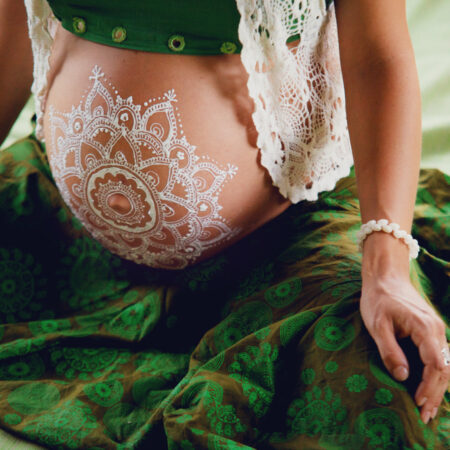Are you curious about those hypnotic geometric tattoos which seem to be so popular these days? Considering getting inked with a mandala but desire a deeper understanding before taking the plunge?
The mandala is an ancient discoid design with a universal significance but a myriad of sacred meanings to many different cultures and religions. We’ve written this article with an idea to help you navigate its complex history and present connotations in a way that’s simple and easy to understand (although we can’t avoid talking in circles).
We will begin by exploring the origins of the mandala and mandala tattoos, explaining their unique presence across the world (including modern western society). Next, we will decode the secrets of the mandala’s unique symbols, shapes, and colors.
We will finish up our adventures in sacred geometry by discussing whether a mandala tattoo is right for you and how to choose a design you won’t regret.
What Is a Mandala?
Simply put, a mandala is a circular geometric design. Although this formation of lines is known by many names to many peoples, the word ‘mandala’ ( its most well-known title) is derived from Sanskrit and means “sacred circle.”
The purpose of these carefully composed shapes is essentially spiritual and representative of the eternal universe. Mandalas are used for a variety of purposes, including trance inducement, tenderly caressing enlightenment, forming a shrine or sacred space, as protection, for healing, as a map of deities, and more.
We will expand upon the various uses below while exploring the mandala’s unique relationship with different cultures and religions.
The ways in which a mandala can be communicated with are as numerous as the ways in which it can be made. A mandala design can be drawn, painted, embroidered, and carved, or it can be arranged temporarily with flowers, leaves, sand, etc. The simple act of creating one is, in itself, a meditative experience. Mandalas can even be tattooed… or you wouldn’t be here!
Further down, we will discuss the equally free-flowing river of symbols, colors, and patterns which define the essence of each mandala’s soul. But first, since it is in the tattooing of mandalas the heart of this article lies, let’s take a short detour on our journey to visit for a moment with the OG of mandala tattoos: Henna.
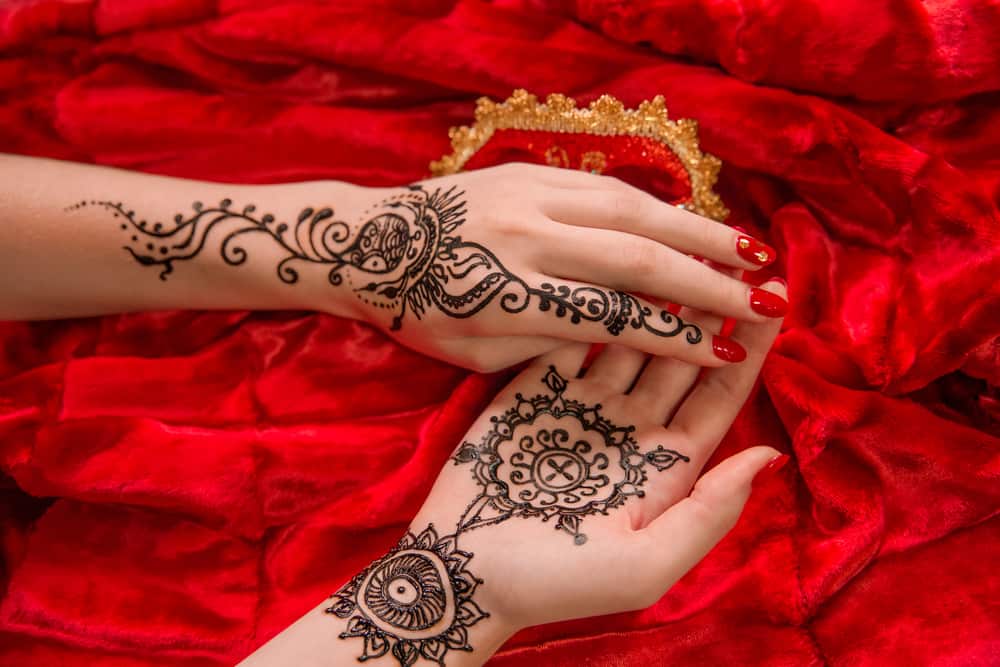
The Origins of Mandala Tattoos
Perhaps it is in understanding the very first people to tattoo a mandala on their skin that we can understand our own motivations behind the desire to do the same.
Mandala Tattoos of the Ancient Maoris and Samoans
The ancient Maoris and Samoans felt so intrinsically connected to their tattoos (often of mandala-like design) that they were willing to undergo the painful process of incorporating the designs onto their physical bodies. Through this sacrifice, they laid an unshakable connection with the soul of the earth.
Henna Mandala Tattoos in India
However, we have to give the title of ‘Mandala Tattoo OG’ to the henna artists of the Indian subcontinent. Painting the fragrant henna mix onto the surface of their skin may have been a pain-free and temporary process, but for centuries past, it has been conducted with as weighty a spiritual air as a Maori’s tribal tattoo.
Still to this day, Indian women’s hands and feet are traditionally adorned with an elegant labyrinth of mandalas and floral designs for special religious occasions, such as weddings.
Henna as an Alternative or Trial Mandala Tattoo
We recommend a henna mandala tattoo as a unique alternative for those who are put off by the idea of pain. If you want a permanent one, this is also a great way to experiment with style and placement before you finalize your piece.
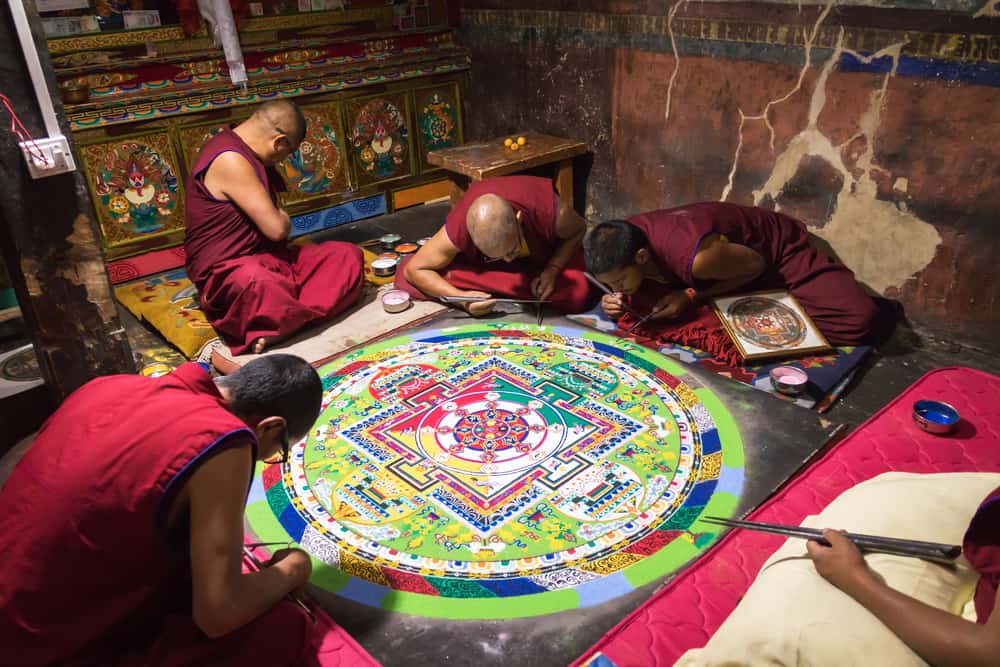
The Religious and Cultural Significance of Mandalas
Although mandalas are most commonly associated with India, Nepal, Buddhism and Hinduism, this metaphysical practice seems to belong to an intrinsic universal human truth. An extension of the birth of life itself, expanding eternally outwards. The encapsulation of all knowledge. The quantum law which all things repeat.
The cellular inspiration to create mandalas has been cultivated in an astonishing number of ancient cultures and religions since the dawn of time. In fact, the oldest surviving mandala can be traced back to the oldest living culture — the Australian aboriginals. It was painted with ochre on the ceiling of ‘Cyclone Cave’ in the Kimberley Ranges at least 50,000 years ago.
In a testament to their fundamental nature, we only had enough space to list a fraction of the known appearances of these global globes. So, please enjoy a glance at some of the world’s most prominent mandala makers and their microcosmic endeavors.
Buddhist Mandalas
Buddha and his monks were instrumental in spreading the art of the mandala around the world. As early as the first century B.C, Buddha’s disciples became worldly pilgrims who left a trail of mandalas along the Silk Road in their wake.
Today, Buddhism (and mandala formation) is practiced all throughout Asia in countries such as Bhutan, India, Nepal, China, Vietnam, and Thailand.
Meditating on the Three Layers of Meaning
To the monk, a mandala holds three layers of meaning: the outer, the inner, and the secret. In order to contemplate these layers, Buddhists meditate upon all the aspects and energies of the mandala. These representations of the divine allow the monks to enter into a trance and experience “Buddha mind” — the embodiment of being/non-being, everything/nothing, life/death.
Sand Art Mandalas
Tibetan Buddhists, in their traditional mountain-side monasteries, spend days carefully forming mandalas from colored sand, only to wipe them away soon after. They use sand to remind them of the impermanence of life.
Hindu Mandalas
As Buddha was born in India, it wasn’t long before the art of the mandala became incorporated into other local religions there. By the 4th century, the mandala had really taken off in Hinduism (also, Jainism).
Hindu Temples
It took on the name ‘yantra’ and evolved into a new, less angular form of tantric practice, gaining relationships with a legion of gods in the process. Mandalas became such an intrinsic part of their religion that Hindus began to use them as a foundation for the design of their temples.
A True Manifestation
Although Hindu mandalas are also complex blueprints used for meditation and ritual (such as puja) in order to experience and honor the infinity of the cosmos, they are considered a true manifestation rather than simply a representation of it.
A core idea of this religion is that rather than a big bang, our universe began with a ‘Rudra’, a roar. Thus, the mandala lives honestly and in perfect harmony.
Flowers, Animals, and Vibrancy
With plentiful lotuses representing the chakras and animals galore, these distinct designs are teeming with life. If you imagine a ‘typical’ mandala with a curly symbol (mantra) at its core and petals blossoming, you are probably picturing a Hindu one.
Buddha may have brought mandalas to the Hindus, but in the flower-power ’60s, the Hindus helped to popularize these vibrant patterns throughout the western world.
Christian Mandalas
Often taking the form of stain-glass windows, wrought-metal, and icons, you may be surprised to learn how easy it is to find a mandala in a Christian church.
But with its first appearance in Christianity dating back to the 12th century, the mandala is a well-established form of artwork within this symbolically-obsessed religion. Christian mandalas can be observed in renderings of the Celtic cross, the crown of thorns, depictions of saints, and illustrations from the Bible.
One of the most interesting examples is the Roman oculus and its surrounding geometric mandala dome. The oculus is a window at the highest central point of a church and yet another mandala acting as a connection between our mundane realm and the heavens above.
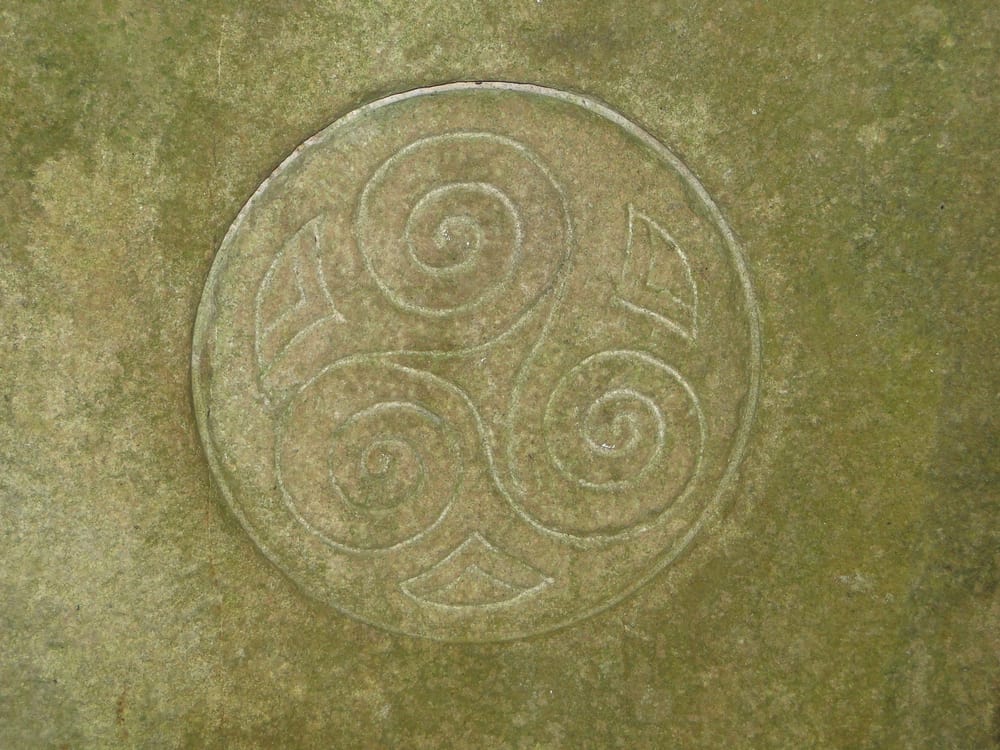
Celtic Mandalas
The existence of the Celtic mandala predates its appearance in Christianity and was first made by ancient druids who discovered that the entirety of the universe could be found in the rings of a tree. Celtic representations of the cosmic balance take three basic mandala forms.
Celtic Knot
This mandala takes its essence from the cycle of life. Its purpose lies in understanding, with clarity of spirit, the way in which your actions and decisions ripple out into the world. A Celtic knot mandala can also be used to communicate with your ancestors.
Celtic Spiral
The wealth of this mandala is in its ability to enhance spiritual awareness, positive energy, and generosity of spirit.
Triquetra
With its three-cornered design, this mandala represents the holy trinity of mind, body, and spirit. It helps to balance these dimensions and, as a whole and grounded being, allows for lively conversations with the ether (and with no roaming charges to boot).
Islamic Mandalas
Anyone familiar with Islamic architecture will understand how intrinsically the idea of eternity is embedded within their art. Wherever the Muslim faith has entered the minds and hearts of a people, so has the wellspring of mandala vision whispered into their dreams.
From the ceilings of traditional family homes to the delicately carved walls of mosques and from glittering mosaic fountains to golden paintings upon the pages of holy books — Islamic mandalas are simply everywhere.
And although the god behind it may have changed his name, to the Muslims, the mandala still serves that universal purpose of contemplating that which lies beyond our frail manipulative powers.
Aztec Mandalas
Aztecs are just one of several Mesoamerican cultures to have left behind some truly epic mandalas. After being lost to the jungle for hundreds of years, many a mossy mandala has been recovered from or preserved within archaeological sites.
Aztec mandalas are fierce and wild, often with a tribal face at their center and extremely intricate detailing. A myriad of birds, beasts, and native plants are carved cyclically and with intent onto massive stone monoliths.
The Aztec Sun Stone
The most famous example of an Aztec mandala is the Aztec Sun Stone, which has been variously interpreted as a calendar, an astronomical guide, a tribute to Aztec earth monster deity ‘Tlaltecuhtli,’ and even a ritual sacrifice altar. Perhaps if these anthropological experts meditate with this mandala, it might reveal its secrets?
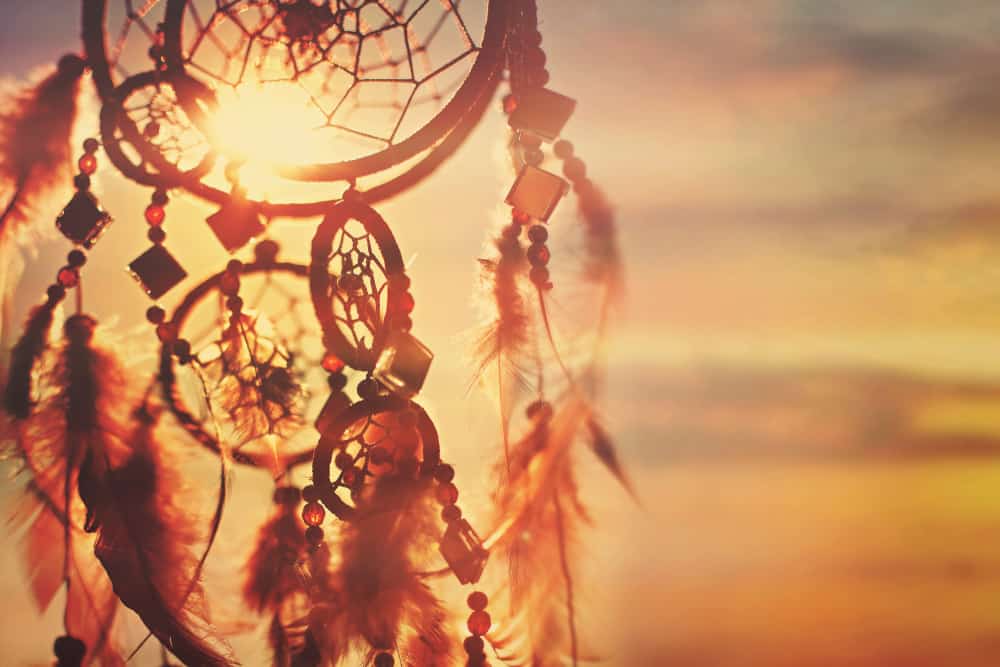
Native American Mandalas
As with Mesoamerican civilizations, mandalas can be observed in many Native American cultures, such as the Lakota, Navajo, and Sioux. Each with their own unique styles and customs, Native American mandalas were used for sacred rites and ceremonies, medicine, and healing.
Navajo Sand Art Mandalas
Buddhists were not the only mandala meditators to make use of sand. For centuries past, Navajo tribesmen have also formed their mandalas with colored grains from the sandy deserts of North America.
Lakota Mandala Dreamcatchers
The Lakota tribe craft theirs as dreamcatchers — delicate spider-weavings of colored thread, decorated with beads and feathers which hang from long strings and dance in the wind. In unison with the universal mandala spirit, these circular nets represented the ‘web of life’ and were used (as the name suggests) to catch unwanted dreams.
Modern “New-Age” Western Spiritualism
The fundamental human need for deeper understanding has inspired generation after generation of American, Australian, and British citizens to fall in love with the gifts of the mandala.
Mandalas and Hippies
As we mentioned above, the hippie pilgrims of the ’60s and ’70s were fundamental in popularizing the art of the mandala in the western world. The crowds of Woodstock descended upon India in their ‘Age of Aquarius’ quest for spiritual enlightenment.
Carl Jung and the Mental Benefits of Mandalas
However, well before Beatles fans were dropping LSD with Gandhi, Carl Jung was already promoting the psychotherapeutic benefits of drawing, coloring, and contemplating the mandala.
In his patients’ abstract geometric designs, Jung observed a reflection of their unconscious and a map of their current state of mind. Still today, mandala drawing is recommended by therapists of the systemically-stressed masses.

The Meaning Behind Mandala Symbols and Patterns
Every culture has its own traditional symbols which, season after season, are planted with care in their mandala-gardens. Each has its special place and purpose, infusing its individual aspect of existence into the context of the mandala.
The borderlines which create the boundaries of a mandala are like bones guiding, supporting, and giving structure to the body. This skeleton is often itself a symbol, such as a star, flower, or wheel. Together, the individual threads of symbol, color, and pattern weave an energetic web and, as a whole, cast their own unique spell.
Below are some common examples of mandala symbols and the significance behind them. When choosing symbols to incorporate into your mandala tattoo design, it is important to focus on what is sacred and meaningful to you. What you want to manifest in your life and what you draw power from. It’s your life and your body, after all.
- Lotus: chakras, enlightenment, purity of soul, emptiness
- Flowers: beauty, hope, compassion, growth, passion, love
- Tree of Life: cycle of life, as above, so below
- Animals: meanings vary depending on the animal
- Sun: vitality, energy, life-force, center of being
- Moon: mind of enlightenment, passivity, intuition
- Star: independent spirit, turning point, change, signs
- Heart: love, nurturing, unity, attraction
- Bell: openness, clarity, receptiveness, femininity
- Wheel: liberation, rebirth, cycle of life, time
- Central Dot: being/non-being, freedom from dimensions, god

The Symbolism of Color in Mandalas
In Tibetan Buddhism, only five colors belong to the mandala. White, yellow, red, blue, and green represent the five: colors of nature, aspects of the mind, wind directions and their center, Buddhas and their families.
In respect to the many cultures for whom the mandala holds other colors or meanings, we have listed a more expansive palette of symbolism below. Contemplating the nature of these colors can help you to form the design of your mandala tattoo or to understand someone else’s.
However, the meanings given are only a guide. As with the symbols above, your relationship to color is a deeply personal matter, and listening to your intuition is key.
- Black: depth, mystery, non-being, singularity, discernment
- White: stillness, emptiness, timelessness, sacred trust
- Yellow: wisdom, striving, humility, nourishment, sun
- Orange: self-awareness, intuition, creativity, restoration
- Red: passion, desire, subjugation, will-power
- Pink: love, receptiveness, subtlety, nurturing
- Purple: spirituality, narcissism, wealth and luxury
- Blue: peace, flow, healing, release, acceptance
- Green: karma, nature, envy, psychic energy, healing
- Brown: earth, grounding, comfort, safety
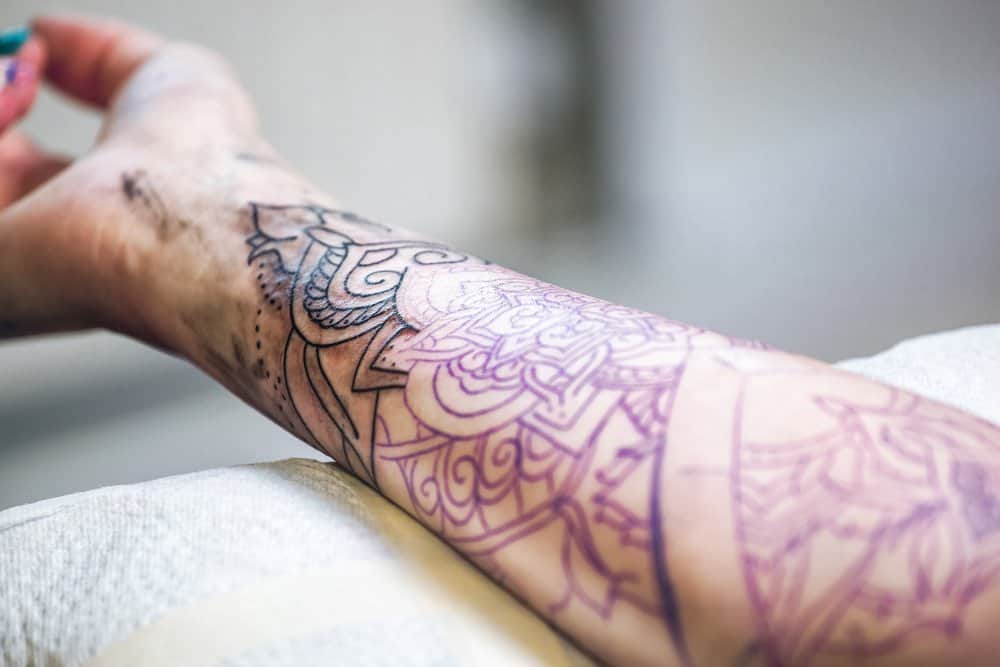
Should You Get a Mandala Tattoo?
There’s a lot to take into consideration when making a decision that will last for the rest of your life. Before the needle touches your skin, we recommend asking yourself a few questions first.
- What does a mandala truly mean to you?
- Does this tattoo connect with you on a deep enough level that you’ll still cherish it in 50 years when your more superficial layers have evolved?
- How do you navigate the tender subject of cultural appropriation?
If you can answer all these questions and still feel the peace of knowing that a mandala tattoo is right for you, then we fully endorse your decision! A tattoo that truly belongs to your body can improve your life and be a source of power and inspiration.
If you don’t feel this way or just don’t know… don’t feel bad. Take all the time you need to navigate and understand what’s right for you. There’s no rush.
How to Choose the Right Mandala Tattoo Design for You
Take into consideration all the information and examples we have provided above whilst tapping into your gut. If you’re a creative soul, the opportunity for personalization here is limitless and encouraged. You can form your mandala around absolutely anything you like! Get wild with your ideas: people, animals, plants, objects, places, colors, telling a story, symbolizing a memory, metaphysical alchemy.
On the other hand, if you feel more comfortable choosing a premade design, then ask your tattoo artist to show you some options. Most tattoo artists will accept images from google and are also capable of drawing up an original design from whatever vague ideas you have.
If you feel connected to or belong to a particular culture, then you may also be able to use a traditional design (with due consideration to its sacred nature).
A final word of advice to potential mandala tattoo recipients: choose your design and then meditate on it. You will find that the very best guidance lies within this wheel of life.
